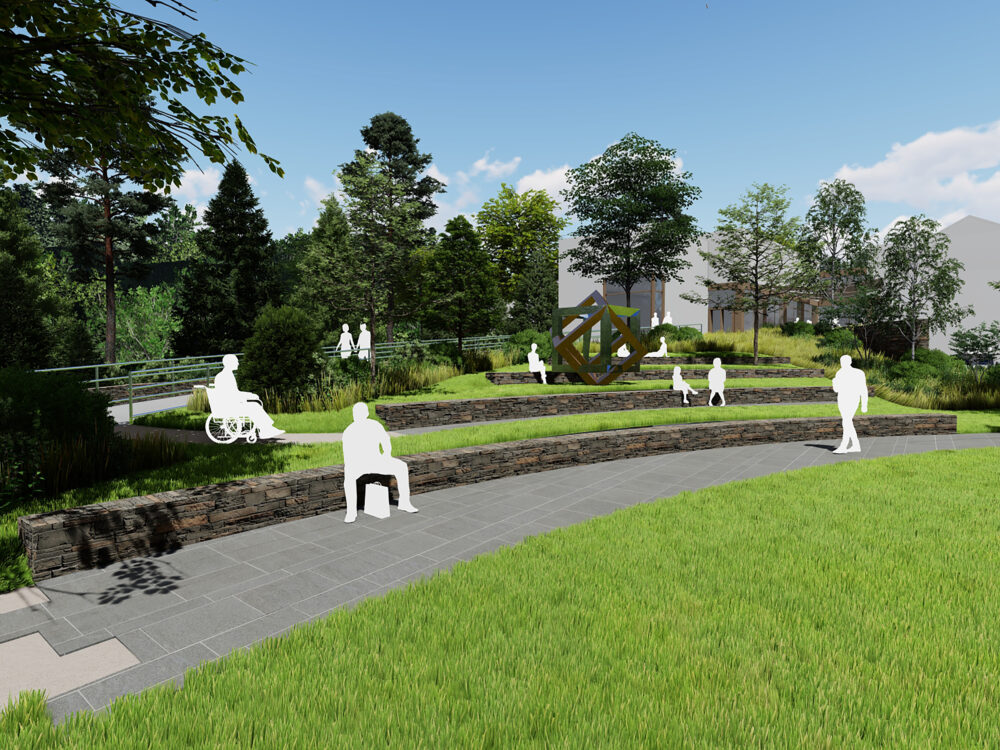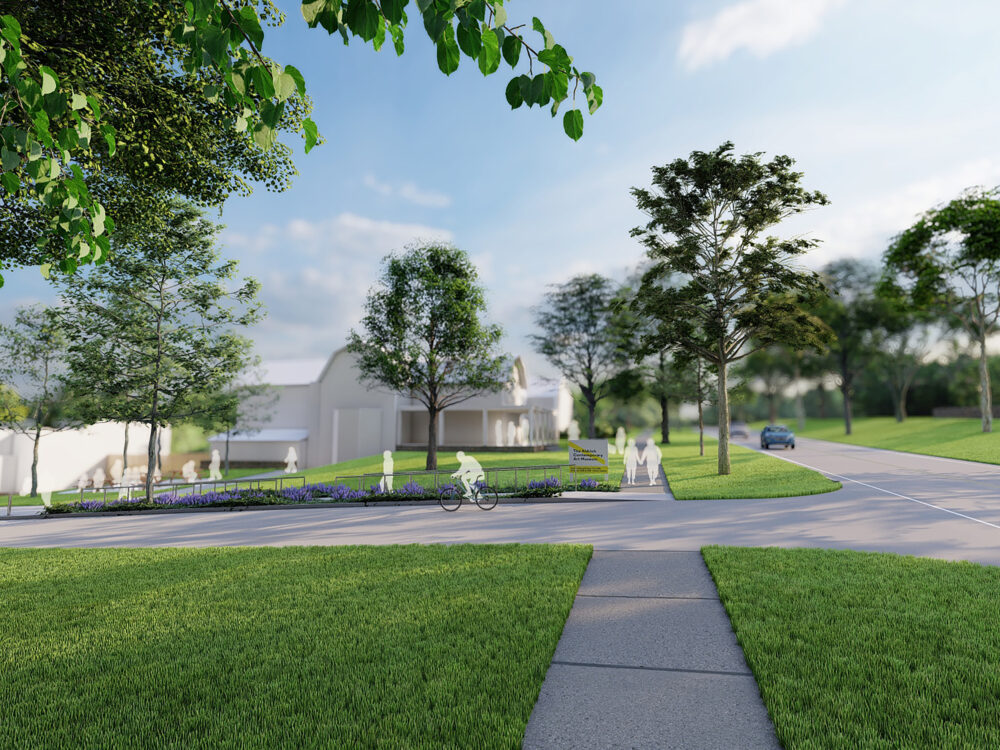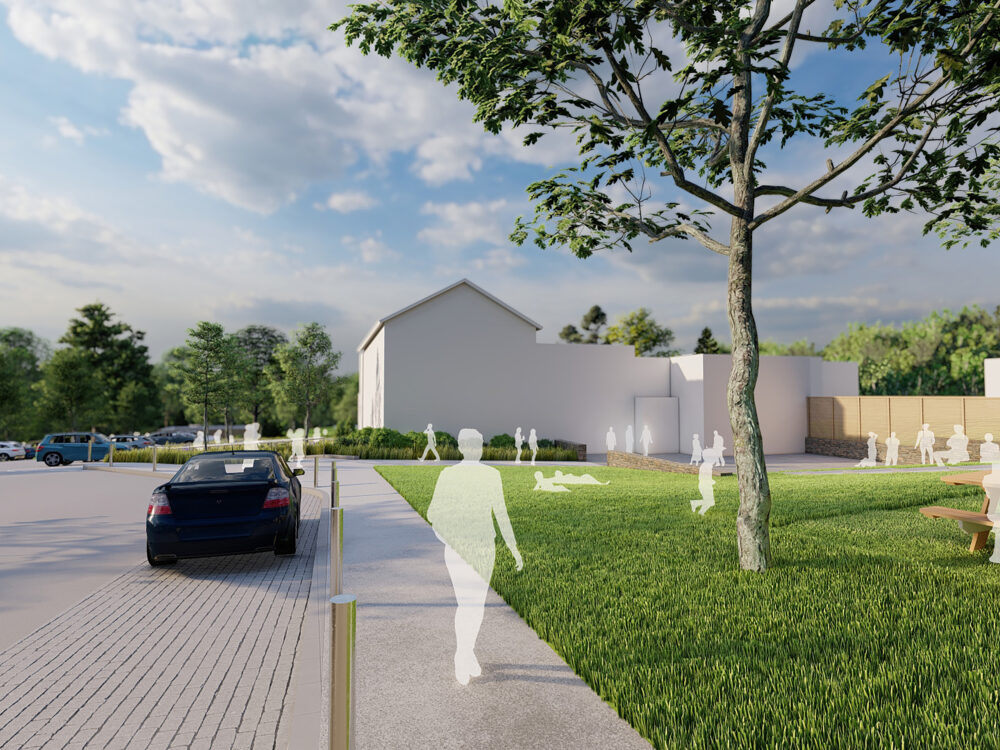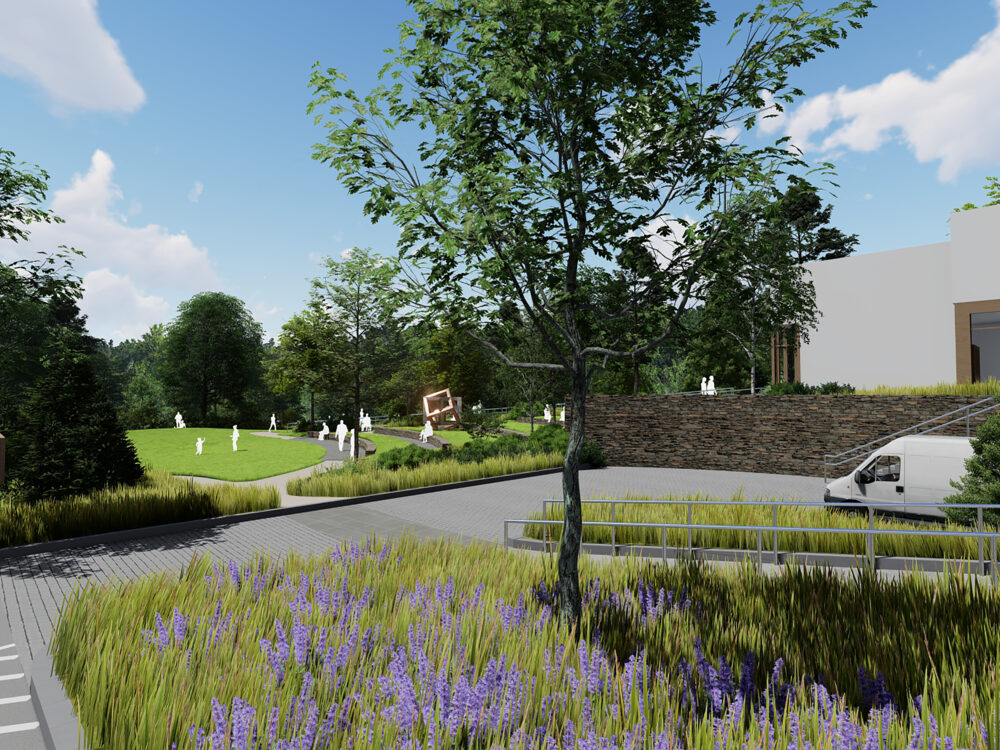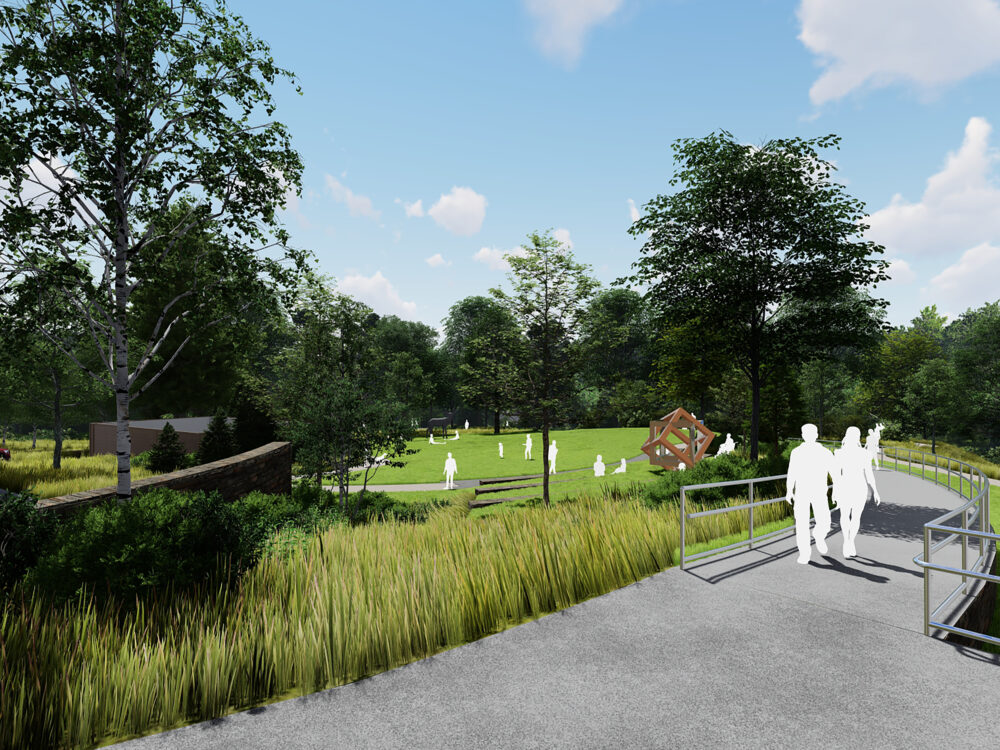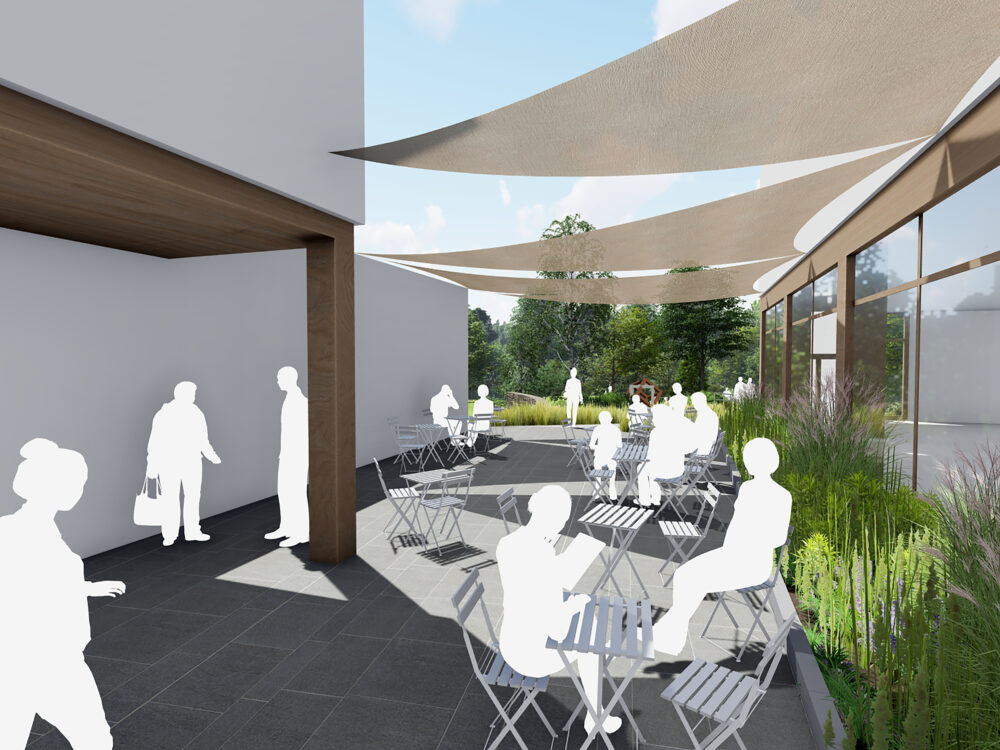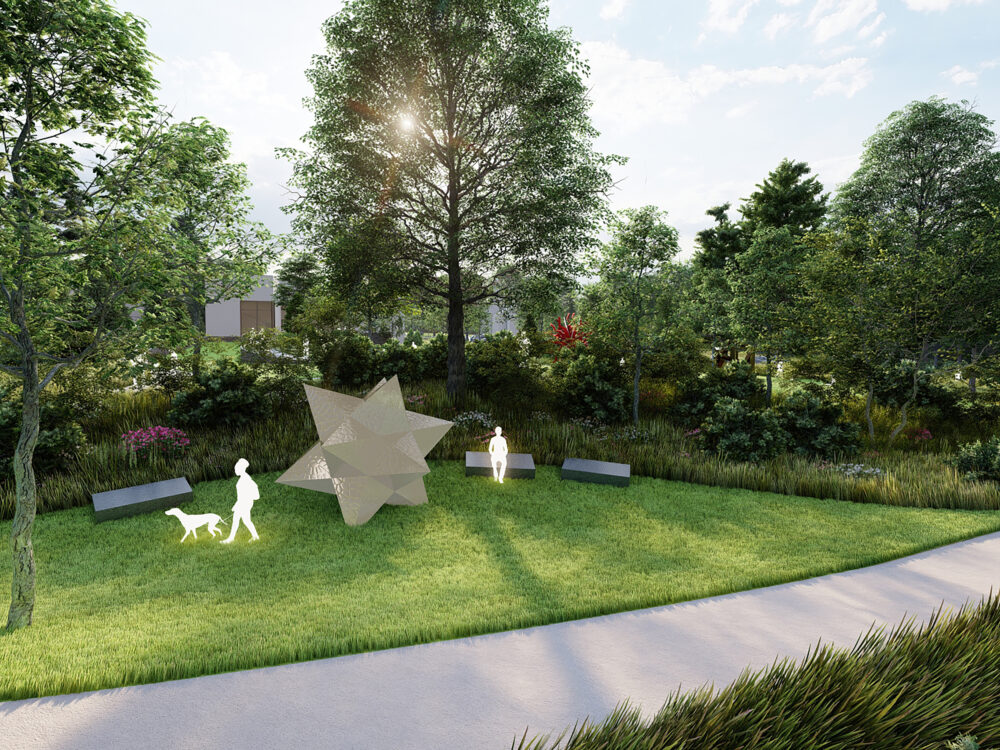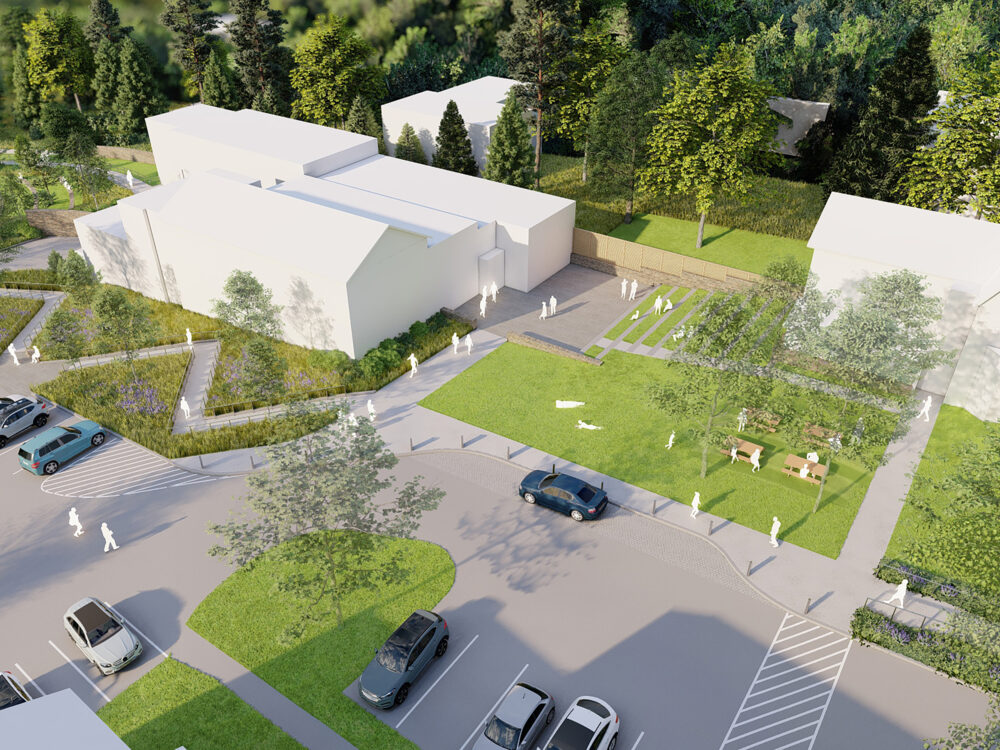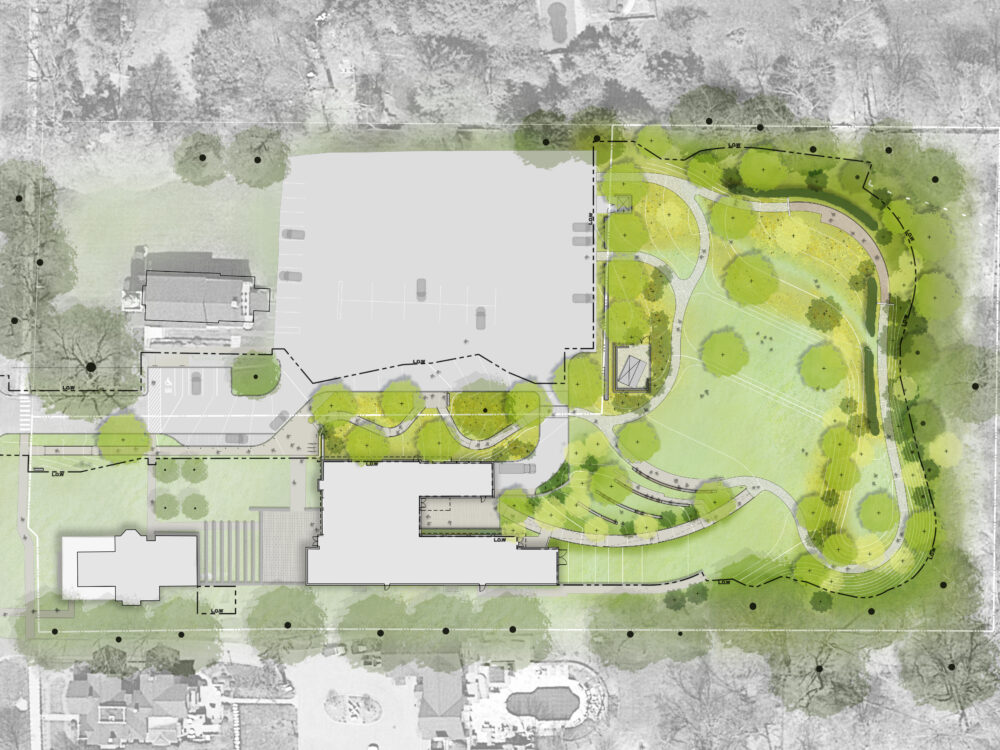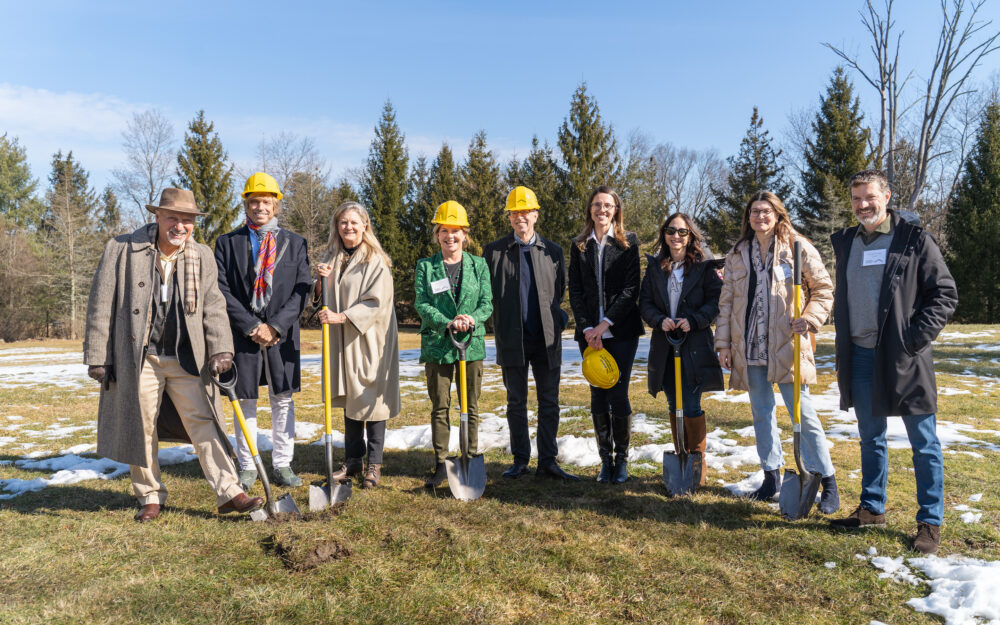- We’re open today from 10 am to 5 pm
- Purchase tickets
- Join mailing list
- Join as a member
- Donate

Campaign for the Sculpture Garden
When The Aldrich was founded in 1964, the presentation of works in nature was a central part of the Museum’s earliest program. Works by artists including Anthony Caro, Alexander Liberman, Tony Smith, and Robert Grosvenor were displayed on the Museum’s campus year-round for visitors and the public to enjoy free of charge.
In 2004, The Aldrich inaugurated a new, state-of-the art $9 million Museum building with modern galleries, an education space, and climate controls. In addition, the Museum’s new building considered audience accessibility—a challenge in the original 18th century building, the Old Hundred—and installed corridors and an elevator designed for visitor ease. The new building enabled significantly more visitors to engage with the Museum’s ambitious exhibition and education programs and serves as dynamic gathering space for the community, while allowing The Aldrich to present significantly more works of art at varying scales.
Now, The Aldrich has united our entire campus by bringing the same level of thoughtful design outdoors, to our three-acre property.
Read the booklet for the Campaign for the Sculpture Garden here.

Landscape Master Plan for The Aldrich
Located in the heart of Ridgefield is a valuable institution for both contemporary art and public space. Not simply a sculpture garden, and not just a series of galleries, The Aldrich provides artists with the unique opportunity to present their work indoors and out. Recent exhibitions, including Frank Stella’s Stars, A Survey and 52 Artists: A Feminist Milestone, have spanned the galleries and the grounds, connecting artists work through the Museum’s galleries and into the public realm.
The Museum’s campus, which extends from Main Street to behind the 2004 building, is a unique space to experience works of contemporary art outdoors. In addition, the Museum provides a significant open space to the community of Ridgefield, bookending the town’s central corridor with Ballard Park. During the pandemic, The Aldrich saw the use of its outdoor space increase dramatically, as visitors from around the community and around the country explored works of art on view outdoors. The Museum embarked on this new Master Plan to meet the expanding needs of our audience.
While the Museum’s campus was well-utilized, The Aldrich understood the significant limitations of the site, including lack of accessible walkways, significant grade changes, and limited sightlines. The Cambridge, MA-based landscape architecture firm STIMSON was engaged and tasked with the goal of identifying the character of the site and its resources and developing a plan for its improvement. With this new plan, The Aldrich could focus its resources on creating a beautiful, universally accessible, native landscape designed for community engagement with works of art in the heart of historic Ridgefield.
Completed Sculpture Garden
Design Process
STIMSON conducted workshops with Museum stakeholders to solicit guidance and input on the site design. The design team and the Board’s Sculpture Garden Committee developed a list of clear goals for the garden design:
- Accessibility and inclusion for all
- Expand the platform for artists with flexibility for exhibitions, events, programming, and community use
- Environmental stewardship
Making the Master Plan a Reality
Building STIMSON’s plan for The Aldrich was transformative for the Museum, linking the inside of the Museum with the campus and dramatically expanding the Museum’s ability to use the three-acre site.
- The Master Plan provides approximately 50% more space available to artists and the community. The Aldrich was limited when installing work outdoors, as sculptures needed to be able to be experienced from a distance or accessible via a short walk on grass from the building. New spaces in the Garden, linked by accessible pathways, including the Secret Garden, Pollinator Pathway, and Boardwalk, significantly increase the number of sites where works of art can be installed and enjoyed, expanding what artists are able to realize at The Aldrich.
- The Amphitheater adds an entirely new programmatic space to the Museum, providing a natural venue for The Aldrich’s presentation of dance, music, and community programs. The Amphitheater also provides a natural gathering place for visitors and adds seating to the Garden, something that was lacking.
- Because of significant grade changes, a large portion of the campus was entirely inaccessible and thus completely unused by the Museum. The Master Plan’s circular pathway allows visitors to walk or utilize a wheelchair from Main Street around the entirety of the campus, giving visitors a significantly expanded opportunity to explore the site.
- Environmental stewardship was a priority for the Museum and the Master Plan, and remediation of invasive species, storm water management, and planting native species, were key features of the project, which improved biodiversity and the site’s overall health.
Most importantly, the Master Plan made the Museum’s entire campus—and all the works of art and programs we present—accessible to the broadest audience. This dramatic change was in service of the artists whose work we support and is in the spirit of connecting their work with our community.
About the Architects
Based in Cambridge and Princeton, MA, STIMSON’s work is shaped by local culture, context, and ecology. Recent projects include the Hackley School, the Florence Griswold Museum, and Harvard University. They were the 2021 American Association of Landscape Architects Firm of the Year.
Estimated Budget
The Aldrich established a $3.6 million budget to make the Master Plan a reality. This expense includes:
- Extensive demolition and construction
- Removal of invasive species
- Planting of trees, bushes, and perennials throughout
- Furniture
- Wayfinding signage
- Legal and town permit fees
Get Involved
Generous support from the Museum’s community is necessary to bring this ambitious project—which has dramatically transformed The Aldrich—to life. Should you be interested in learning more about naming opportunities or how to get involved, please contact:
Cybele Maylone
Executive Director
cmaylone@thealdrich.org
203.438.4519 x 116
Supporters
The Amadeo Family
Anne S. Richardson Fund
Anonymous
Sonia Attkiss
Bafflin Foundation
Deborah Barnett-Brandt and Robert Brandt
In loving memory of David Beitzel
-Skip, Tish, and Darren
Gerald Blitstein and Randye Kaplan
Christine and Jeff Boris
Bowes/Weller Family Foundation
Melinda and Brian Carroll
Jean-Jacques Chaltiel and Sarah Gondell
Wear Culvahouse and Douglas Graneto
Steve and Roberta Denning
Design Within Reach
Eric G. Diefenbach and James Keith Brown
Helen Dimos and Ben Oko
Anita and Nick Donofrio
Michael P. and Linda M. Dugan
Fairfield County Bank
Jeanne Donovan Fisher
Vida Foubister and Tim van Biesen
Carol and Dave Foster
In loving memory of Dexter R. Giroux
-Anne Giroux and Olivia Giroux-Galpin
Gail and David Gluckman
Liz and Steven Goldstone
Rachel and Peter Goulding
Gigi Grussing
Helena Hernmarck
Becca Hoblin
Lin and Stephen Jamison
Patricia and Lawrence Kemp
Dara and Evan Kingsley
Kristina and Philip Larson
Raymond Learsy
Philip and Christine Lodewick
Long Family Charitable Trust
Douglas and Kaye Malton
Neil and Lisi Marcus
Miriam G. Martinez and Roger Restaino
The Mueller Family
The Norwitt Family
Annette and Dan O'Brien
Amy Pal and Kevin Manley
Julie Phillips Family
Kirsten and Andy Pitts
Sarah Tod Fund
Pam and Scott Schafler
Carla Shen and Chris Schott
Sonia Skindrud and Bill Covell
In honor of Melinda Carroll
-The Simone McEntire Charitable Fund
The Sondheimer Family
Sabina and Harlan Stone
The Streator Family
Torrey Family Foundation
Sherie Snyder and Angus Vail
Whip Salon
Vaughn C. Williams
List in formation. This list represents gifts of $1,000 or more in support of the Campaign for the Sculpture Garden and Inaugural Programming.
This project was funded in part through the State of Connecticut Good To Great and Urban Act grants.
The Master Plan was supported by generous grants from the Anne S. Richardson Fund and the Leir Foundation.
Related News
Update: Sculpture Garden Renovations
We’re thrilled to share that the renovations to our grounds and Sculpture Garden are continuing to go smoothly. This week trees were planted in the Sculpture Garden.
Sculpture Garden Renovation Update- Q&A with STIMSON's Eddie Marshall
We asked Eddie Marshall, Principal and Landscape Architect at STIMSON, a few questions about how the Sculpture Garden renovation project has been going so far.
Sculpture Garden Groundbreaking on February 26
On February 26, 2024 The Aldrich Contemporary Art Museum hosted a groundbreaking ceremony to inaugurate the commencement of its Campus and Sculpture Garden Renovation Project, slated to be completed Fall 2024.
Top image: Sculpture Garden Photography by Adam Bernier
